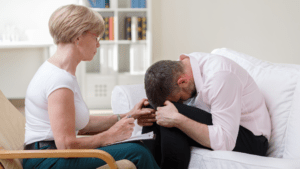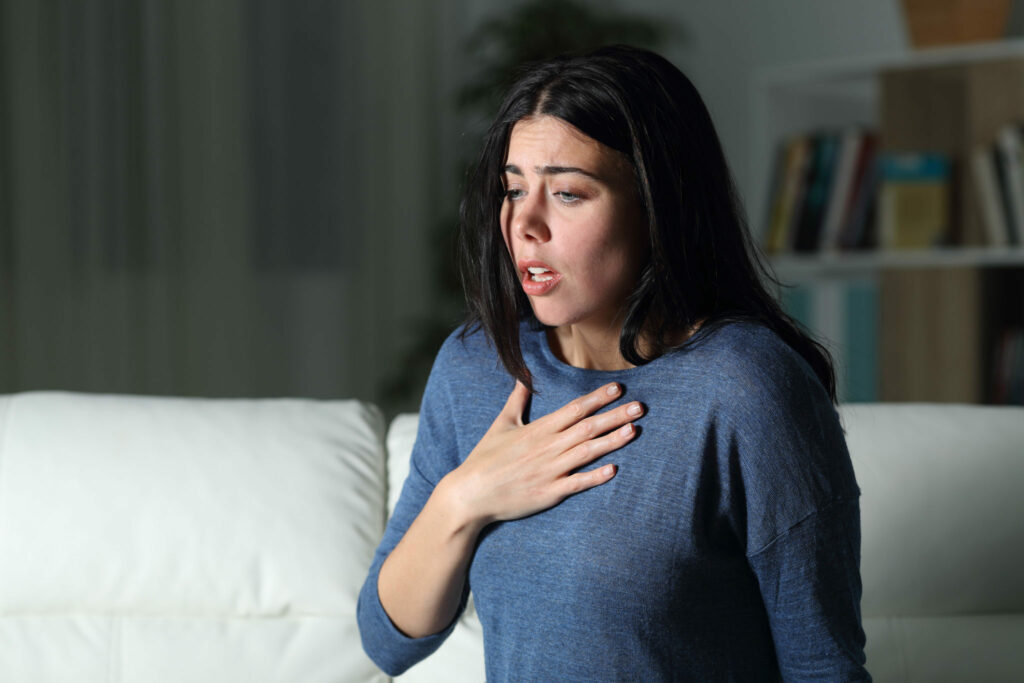What do you do when a ptsd attack hits? It can be difficult to know how to handle an emotional crisis. If you are experiencing a ptsd attack, it is important to remember that you are not alone. There are many people who understand what you are going through and want to help. In this blog post, we will discuss some steps that you can take to get through a ptsd attack.
Contents
What Is PTSD Attack? 
PTSD attacks are sudden, intense episodes of anxiety that can last for minutes or even hours. Many people with PTSD will experience multiple attacks over the course of their illness.
Attacks can be triggered by anything that reminds the person of their trauma, such as a sound, sight, or smell. During an attack, people with PTSD may feel like they’re going to die or lose control. They may also have physical symptoms like a racing heart and trouble breathing.
What Are The Symptoms?
A PTSD attack can be overwhelming and cause a great deal of distress. Symptoms of a PTSD attack can include:
- Intrusive thoughts or memories of the traumatic event
- Flashbacks to the trauma
- Nightmares about the trauma
- Avoidance of people, places, or things that remind you of the trauma
- Negative changes in your thinking or mood, such as feeling hopeless, losing interest in activities you used to enjoy, or feeling detached from others
- Changes in your physical reactions, such as being easily startled, having trouble sleeping, or experiencing angry outbursts.
What Are The Causes?
There are a number of things that can trigger a PTSD attack. These include:
Seeing or hearing similar to the traumatic event 
PTSD attacks can be triggered by anything that reminds you of the traumatic event. It could be a sound, a smell, or even a person. Anything that brings back the memories of the trauma can trigger an attack.
For example, let’s say you were in a car accident. The sound of screeching tires might trigger an attack because it reminds you of the accident. Or, if you were attacked by a dog, the sight or sound of a dog might trigger an attack.
Being in a place similar to that trauma
For some people with PTSD, being in a place that reminds them of the traumatic event can trigger an emotional crisis. This might happen if they see something on the news that reminds them of the event, or if they drive past the location where the event took place. Sometimes, just hearing someone else talk about a similar experience can trigger an emotional crisis.
For instance, imagine that you were in a place during a terrorist attack. You might have seen people killed or injured, and you may have been scared for your own life. If you go back to that place, you might start to feel like you’re going to die. Your heart rate might increase, and you might start to sweat. You might even feel like you’re going to faint.
Feeling physical sensations
For some people with PTSD, physical sensations can trigger an emotional crisis. This may be because of the way the body responds to a traumatic event. The fight-or-flight response is a natural reaction that happens when we feel threatened. It causes our heart rate to increase and our breathing to become shallow. We may also sweat more and our muscles may tense up.
For people with PTSD, these physical sensations can trigger memories of the trauma and cause them to feel like they are in danger again. This can lead to a feeling of panic or anxiety. In some cases, it may even cause a full-blown PTSD attack.
Seeing original trauma happening to someone else
It happens indeed. Let’s take an example. Let’s say, you are a PTSD attack survivor and you see on the news that another mass shooting has taken place. You might have a PTSD attack because you feel like you are reliving the trauma all over again. It’s normal to feel this way and it doesn’t mean that you are weak.
Another reason why it triggers PTSD attacks is that you might be feeling hopeless and helpless. You feel like there is nothing you can do to stop it from happening again.
PTSD attacks can be triggered by seemingly unrelated events because they can serve as a reminder of the traumatic event. For example, an argument with your partner may remind you of a time when you were attacked and feel like you are in danger again. Getting stuck in traffic may remind you of being in a car accident and feeling helpless. These reminders can trigger an emotional response that feels out of proportion to the current situation.
Anything that causes you to feel overwhelmed, stressed, or scared can lead to an attack. These triggers can be anything and vary from person to person. It is important to be aware of your own triggers and try to avoid them if possible. If you cannot avoid them, it is important to have a plan in place for how to deal with them should they occur.
How Can Therapies Help?
There are various types of therapies that may help you manage and overcome PTSD attack issues. Some very useful are as follows:
Cognitive Behavioral Therapy
CBT helps people understand how their thoughts, feelings, and behaviors are connected. It can also help people learn new ways to cope with symptoms. 
CBT is a form of psychotherapy that helps people manage and overcome their ptsd attacks by changing the way they think and behave. The aim is to help people identify, challenge, and change negative thoughts and behaviors that are contributing to their ptsd attacks.
One of the most important aspects of CBT is learning how to identify distorted or unhelpful thinking patterns, also known as cognitive distortions. These are beliefs that we hold about ourselves, others, and the world around us that can lead to feeling anxious or down. Once we become aware of these thinking patterns, we can start to challenge them and look at things in a more realistic and helpful way.
Exposure Therapy
This type of therapy helps people face their fears in a safe and controlled environment. It can be done in person or through virtual reality simulations.
Further, exposure therapy helps people manage and overcome their fear of particular situations, objects, places, or events that may trigger memories of a traumatic experience. The goal of is to help people learn to control their anxiety and fear by gradually exposing them to the things they’re afraid of in a safe and controlled environment.
For example, someone who has PTSD may be afraid to leave their house because they worry about having another panic attack. Exposure therapy would involve slowly helping them approach their fear by first going outside for short periods of time, then gradually increasing the amount of time they spend outside until they no longer feel anxious or scared.
Eye Movement Desensitization And Reprocessing
EMDR helps people to process and overcome trauma. It is considered an effective treatment for post-traumatic stress disorder (PTSD). This type of therapy can help people to manage their symptoms and to feel more in control of their lives.
EMDR works by helping people to process and make sense of their memories, thoughts, and feelings about a traumatic event. The therapist will guide the person through different eye movements, while they focus on the upsetting memory. This helps the person to process the memory in a new way so that it no longer feels as distressing.
EMDR has been found to be particularly helpful for people who have experienced complex trauma, such as child abuse or neglect, sexual assault, or domestic violence. This therapy can also be helpful for people who have experienced single-incident trauma, such as a car accident or natural disaster.
Art Therapy
This is the therapy that can help people with PTSD in a number of ways. The first is by providing an outlet for the emotions that are bottled up inside. When people are suffering from PTSD, they often bottle up their emotions and don’t know how to express them. Art therapy provides an outlet for those emotions and allows the individual to express themselves in a safe and controlled environment.
Another way art therapy helps manage PTSD is by helping the individual to process and make sense of their trauma. Often, people who have experienced trauma have trouble making sense of what happened to them. Art therapy can help them to make sense of their experiences and start to work through the trauma.
Finally, art therapy can help people develop coping mechanisms for dealing with their symptoms. Often, people with PTSD can feel like they are alone and that no one understands what they are going 0through. Art therapy can help them to develop coping mechanisms and find ways to deal with their symptoms.
Psychodynamic Therapy
This therapy focuses on understanding the root cause of someone’s PTSD symptoms. It can help people identify and work through traumas from the past.
Psychodynamic therapy focuses on helping people understand the psychological factors that contribute to their emotions and behaviors. It can be used to treat a wide variety of mental health conditions, including ptsd attacks.
It helps people with ptsd attacks by providing them with a greater understanding of their condition. Psychodynamic therapy can also help them learn how to cope with their symptoms and manage their emotions in a more effective way.
Various techniques are used such as exploring past experiences, dreams, and fantasies. By becoming more aware of these things, people with ptsd attacks can learn to control their thoughts and emotions in a more positive way.
Group Therapy
This type of therapy helps people with PTSD to share their experiences with others who understand what they are going through. This can be a very powerful experience, as it can help people to feel less alone and to realize that they are not the only ones who have been through something traumatic.
Group therapy can also provide people with an opportunity to learn new coping skills and to practice using these skills in a safe and supportive environment. In addition, group therapy can help people to develop a stronger support network of friends and family members who can offer practical and emotional assistance when needed.
Finally, group therapy can help people with PTSD to access community resources that can assist them in their recovery. For example, many communities have support groups for survivors of trauma that meet on a regular basis. These groups can provide people with practical information about resources such as housing, financial assistance, and counseling services.
Hypnosis
During hypnosis therapy, the therapist will guide the person into a state of relaxation where they are more open to suggestions. The therapist will then work with the person to help them address their symptoms and learn coping techniques.
For example, if a person is having flashbacks of a traumatic event, the therapist may help them to imagine themselves in a safe place where they feel in control. This can help the person to feel more safe and secure when they are experiencing a ptsd attack.
There are many different techniques that can be used in hypnosis therapy, and the therapist will tailor the approach to meet the needs of the individual. The goal is to help the person to manage their symptoms and ultimately overcome their ptsd. With time and commitment, hypnosis therapy can be an effective treatment for ptsd.
All of these therapies can be helpful in managing PTSD symptoms. It is important to find a therapist that you trust and feel comfortable with. You may need to try different types of therapy before you find one that works for you.
How Medications Can Help?
There are various medications that can help manage and recover from a ptsd attack. Some examples include:
- Selective serotonin reuptake inhibitors (SSRIs): These can help improve mood and sleep.
- Serotonin and norepinephrine reuptake inhibitors (SNRIs): These can also help with mood, as well as pain.
- Tricyclic antidepressants: These may be helpful for people who don’t respond to other medications.
- Monoamine oxidase inhibitors (MAOIs): These are typically reserved for people who don’t respond to other treatments.
- Antipsychotics: These can be used to treat delusions, hallucinations, and paranoia.
- Benzodiazepines: These can help with anxiety, agitation, and insomnia.
Speak with a doctor to see if any of these medications may be right for you. It’s important to note that it may take some trial and error to find the right medication or combination of medications that work best for you.
Medications can also have side effects, so it’s important to closely monitor your symptoms and speak with your doctor if you experience any adverse effects.
How Self-Care Tips Can Help? 
There are a number of self-care tips that may help manage and recover from ptsd attack:
- Talk to someone who understands: This could be a therapist, doctor, or even a friend. It’s important to have someone to talk to who understands what you’re going through.
- Create (or find) a support system: A support system can provide practical and emotional assistance. This might include family, friends, co-workers, or others in your community.
- Identify your triggers: Once you know what causes your ptsd attacks, you can try to avoid those triggers or be prepared for them if they do occur.
- Practice relaxation techniques: Relaxation techniques can help you manage stress and anxiety. Some relaxation techniques include deep breathing, progressive muscle relaxation, and meditation.
- Exercise: Exercise can help improve your mood and reduce stress. It’s also a great way to get rid of pent-up energy that can make ptsd symptoms worse.
- Get enough sleep: Sleep plays an important role in managing ptsd symptoms. Most adults need seven to eight hours of sleep each night.
- Avoid alcohol and drugs: Alcohol and drugs will only make ptsd symptoms worse in the long run. If you’re struggling with ptsd, it’s important to avoid these substances.
- Maintain PTSD Journal: Keeping a PTSD journal can be a helpful way to track your symptoms and progress. It can also be therapeutic to write about your experiences.
- Believe in yourself: ptsd can be a difficult battle, but it’s important to believe in yourself and your ability to overcome this challenge.
These self-care tips can be incredibly helpful in managing ptsd symptoms. Remember, you are not alone in this battle. These useful strategies may help you through this difficult time.
Conclusion
People who are more likely to experience ptsd attacks should be aware of the symptoms and know how to deal with them. PTSD, or post-traumatic stress disorder, can happen after a person experiences or witnesses a traumatic event. Symptoms may not show up until months or even years later. For some people, these symptoms never go away.
You may feel like you’re in danger even when you’re not. This can make it hard to do things you used to enjoy or be around people who remind you of the trauma. But, remember, life is a journey with many ups and downs. You can get through this. Have faith in yourself and your ability to heal.
For more information, please contact MantraCare. PTSD or Post-Traumatic Stress Disorder is a mental health condition that affects people who have experienced or witnessed a traumatic event. If you have any queries regarding Online PTSD Counseling experienced therapists at MantraCare can help: Book a trial PTSD therapy session






